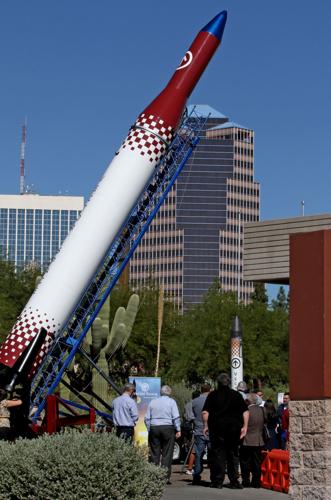If you have a job, you may have labored under the same misunderstanding that I have for the last few months about Tucson’s job market.
But if you weren’t laboring, you probably did understand.
I’ve been thinking Tucson’s economy had finally “turned the corner,” as they say. That we had finally shaken off the Great Recession blues. That jobs were becoming plentiful and better-paid.
It’s easy to see why. Here in downtown, where I’m writing this, there are five construction projects within a couple of blocks, suggesting a boom time. And even beyond this construction zone, there has been great economic news for the region.
Caterpillar announced it is moving a regional headquarters here, adding up to 600 well-paying jobs.
Two space companies, Vector Space Systems and World View Enterprises, announced they plan to stay and grow here. Over five years, Vector and World View hope to add up to 900 good jobs.
And most importantly, Raytheon Missile Systems announced last year it plans to add at least 1,900 jobs on land near its current plant at Tucson International Airport, potentially drawing other suppliers to the site as well.
These were all big psychological boosts and created a welcome sense of momentum for Southern Arizona. I wrote a column in May 2016 headlined “Be careful — economic optimism is in Tucson’s air.” I cited some of these economic-development wins as well as findings by UA economist George Hammond that the local economy was growing faster than expected.
But that perception has run into a wall called reality. And coincidentally, I started noticing that about a month ago at a presentation by Hammond, the director of the economic and business research center at the UA’s Eller College of Management.
The third slide in that presentation showed Tucson’s job growth versus comparable cities in the broader Southwest. At 1.3 percent growth, Tucson was last by a long shot. Only Albuquerque was close, at 1.7 percent. Phoenix: 3.1 percent.
Our wages, too, were well below the median, Hammond reported, helpfully adding that this is “not explained just by cost of living.” In other words, yes, it’s relatively cheap to live here, but no, that’s not why our pay is so low.
Even our one seeming advantage — higher levels of college attainment — is a bit of a mirage, Hammond reported. It’s skewed by the high number of retirees with bachelor’s degrees who move here. Working-age residents have a lower rate of college attainment than the overall population.
The overall feeling of Hammond’s presentation was meh.
Now, six weeks, after that uninspiring forecast, the state is reporting similarly blah news about the Tucson metro area’s economic performance. While the number of jobs in Arizona grew by 2.4 percent from June last year to June this year, that growth happened mostly in Maricopa County.
The Tucson area added just 1,900 jobs in the same year, for 0.5 percent growth. That’s not enough to keep economic optimism afloat.
The problem seems to be that what boosted our optimism were announcements of relatively small projects that will be spread out over years. They don’t necessarily reflect a robust underlying economy.
“The scale of the announcements has seemed to me to be pretty small relative to the overall size of the Tucson economy,” Hammond told me Friday.
Bill Assenmacher, CEO of steel-fabricating company Caid Industries, told me his company hit some new heights last year, but its growth has leveled off.
“Right now we’re feeling a little lull in the general economy,” he said.
Hammond noted the Tucson area, which includes all of Pima County, would need to add 7,500 jobs per year just to come close to the state growth rate at 2 percent.
Also, we have had some surprising shrinkage in an important category of good-paying jobs, “professional and business services.” That category includes engineers, architects, accountants and others who usually have a professional degree and make good salaries.
We lost 2,100 of those jobs in the Tucson area between June of 2016 and June this year, the latest state reports say. Hammond called it “a puzzling weakness that I can’t explain.”
You might apply that phrase to the local economy overall. Even after a hopeful 2016, it remains puzzlingly weak.





